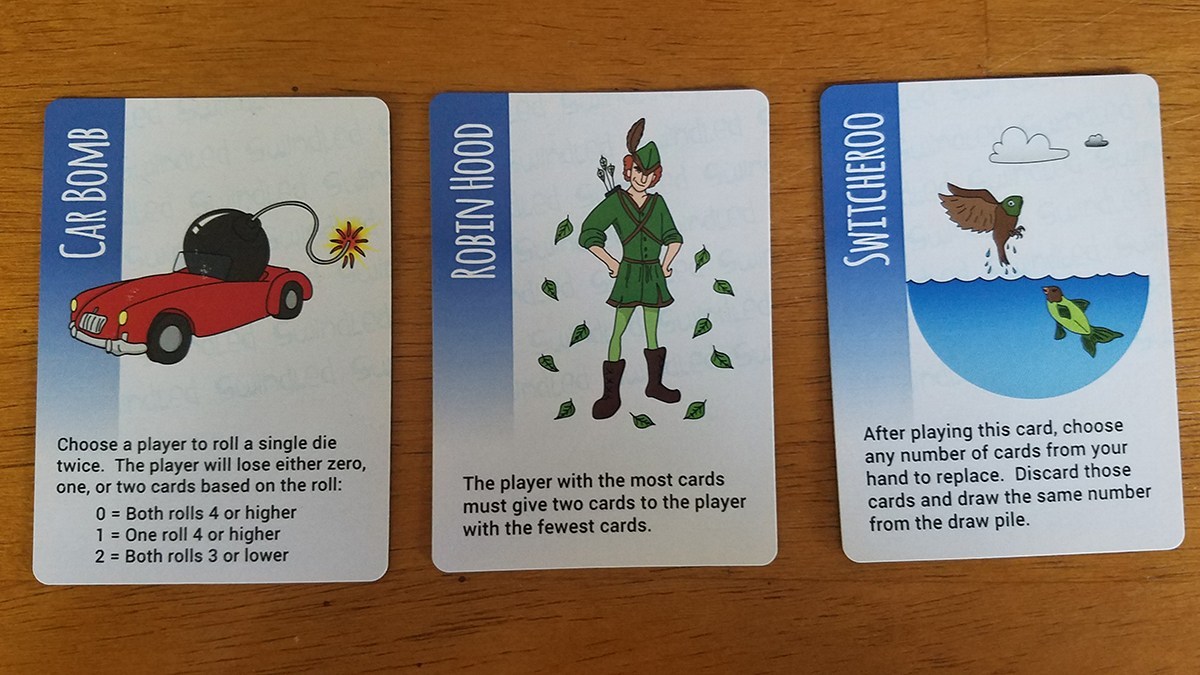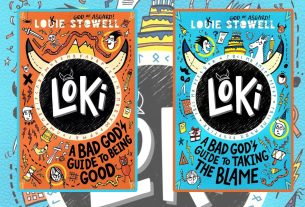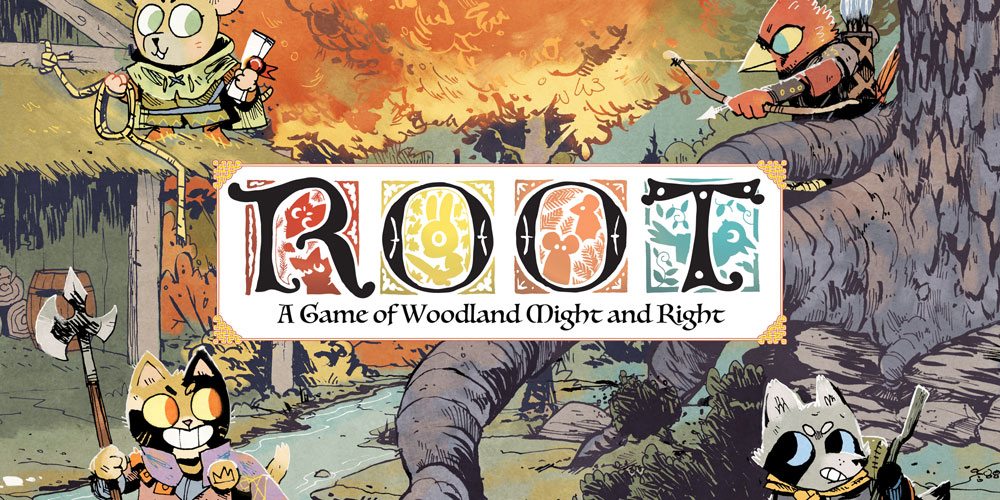What Is Swindled?
Swindled is a game for 2-6 players, ages 8 and up, and takes about 20 minutes to play. It’s currently seeking funding on Kickstarter, with a pledge level of $23 for a copy of the game.
New to Kickstarter? Check out our crowdfunding primer, and visit our Kickstarter curated page for more projects we love.
Swindled Components
Note: My review is based on a prototype copy, so it is subject to change and may not reflect final component quality.

- 129 Cards (note that the Kickstarter pages says there are 181 cards)
- 6 Color Cards
- 6 Pawns
- 3 Dice
- 3 Angels and Demons Tokens
- 5 Turn Tokens
- 1 Bag
Most of the components are off-the-shelf pieces for the prototype, so I cannot really comment on the quality of those pieces.
The cards, however, are the main part of the game. While I can’t promise that the artwork on the cards is final, it appears from the Kickstarter page that it might be.
The cards are simple, but that’s a plus in my eyes. Each card has a title down the side, some descriptive text of what to do when the card is played, and then simple, cartoony artwork. The art isn’t going to win any awards, but it does fit the theme and overall tone of the game.

The cards fall into three colors. Most of them are blue, which are simply cards you play when its your turn. A smaller number of yellow cards can be played out-of-turn in response to another player’s action, and an even smaller set of red cards are forced actions. Each card’s color is designated by a strip of that color where the title is, but also as a faint tint in the background of the card, so there’s never any confusion.
How to Play Swindled
Swindled is played like most basic card games, in a series of rounds where each player simply plays a card.
The Goal
The goal of the game is to be the last person with cards in their hand.
Setup
Each player chooses a color and takes the appropriate pawn and color card. These won’t be used immediately, but will likely come into play later.
Then, the deck is shuffled and each player is dealt a hand of 7 cards. The first player can be determined by rolling the dice.
Gameplay
On a player’s turn, they play a card from their hand and do what it says.
This is definitely one of the games that you can’t overthink. There’s nothing more to it than playing a card.
Except … well, the cards are varied, and there’s a lot that happens with each played card.
Before I go into that, a few key rules:
- Once you play your last card, you’re out, and if you have a card in your hand, you have to play it. So careful card management can be key, as there are cards that allow you to draw more cards.
- You cannot pass on a turn.

The color cards, showing the front and back. Image by Rob Huddleston - Once a player is eliminated, they turn their color card over to show their new, sad status. There’s no way to return to the game, but don’t worry, as games are usually fast enough that you won’t be out for too long before another game starts.
There are 46 different types of cards in the game. Obviously, I’m not going to cover every one here. Instead, I’m going to just pick out a few key ones that I think best reflect the flavor of the game, or the ones that specifically use the extra components included with the game.
What makes Swindled interesting, and not just another version of the thousands of card games before it, is that a lot of the cards trigger “mini-games” against opponents, usually with a reward of either getting to draw more cards or forcing opponents to discard.
Angels and Demons: This mini-game lets you press-your-luck. The three tokens–two angels, one demon–are placed in the bag. Then, the player who played the card chooses either to draw, or to force an opponent to draw. If the token drawn is an angel, the player doing the drawing gets a card. If the demon is picked, they discard two cards.
Bank Heist: This quickly became the favorite of the mini-games. The person who played the card chooses two other players to join the “crew”. Then, each person in the crew rolls a die. If all three roll 4 or higher, each player in the crew draws 5 cards. However, if only one rolls a 4 of higher, no one wins any cards. But any players who rolled less than 4 has to discard a card.
Can’t Hold It In: One of the red cards. It doesn’t do anything, but on your next turn you play it. However, it can be stolen or discarded if you can somehow con another player into doing one of those to you before your next turn.
Casting Lots: One of the cards that uses the pawns. In this mini-game, every player, including the one who played the card, puts their pawn in the bag. The player who played the card draws one pawn, and then steals a card from the person whose pawn they drew. If they draw their own pawn, nothing happens.
Copycat: One of the yellow cards, you can play this at any time on someone else’s turn, and gain whatever benefit they gained from whatever card they played.
Diseased: Another of the red cards. This one is placed face-up in front of another player, and as long as it is there, they have to discard an extra card each turn. There’s a Cured card that can save them, if they can find and play it before it’s too late.
Hot Potato: When played, the person to the left of the current player rolls a die. If they roll a 6, they discard a card. If they don’t, then the next person to their left rolls. This continues, as many times around the table as necessary, until a 6 is rolled.
Inheritance: All pawns are placed in the bag, then drawn one at a time. The player who owns the first pawn drawn must give 2 cards to the player whose pawn is drawn last.
Puppet Master: You choose another player and put the card in front of them. On their turn, you look at their hand and choose which card to play, and then play it for them, making any decisions and rolls for them. Once their turn is completed, the card is discarded.
Taco Vendor: Another red card. You must discard it immediately.
Again, this is a very partial list to give you an idea of what kinds of cards are in the deck, and why it’s more than just a simple draw-and-discard game.
Game End
The game ends when only one player has any cards left. They win, and everyone else loses.
Why You Should Play Swindled
Swindled is much more fun than it appears at first glance. The mini-games are what really set it apart. They keep everyone engaged and interested throughout the game, as you never know when you might get dragged into someone else’s turn.
The game isn’t deep on strategy, but it isn’t supposed to be. It’s marketed as a party game, so it’s designed to be a fast, light game you pull out when your objective is to just have lots of laughs. And laugh you will.
There’s a lot in the game, and for only $23, Swindled is a game worth backing.
For more information or to make a pledge, visit the Swindled Kickstarter page!
Click here to see all our tabletop game reviews.
![]() To subscribe to GeekDad’s tabletop gaming coverage, please copy this link and add it to your RSS reader.
To subscribe to GeekDad’s tabletop gaming coverage, please copy this link and add it to your RSS reader.
Disclosure: GeekDad received a copy of this game for review purposes.






Thanks for the review, Rob! I always enjoy reading about games on Kickstarter. I thought the mini game aspect of this one was really cool. It was very smart of the project creator to market the game as a “party game” rather than try and say it is a strategy game. I’m definitely going to check out their project page. While $23 is an inexpensive game in general, I worry that lots of people will have a hard time committing to that price point unless they can see some more professional artwork for the game. What do you think? Thanks again for the great content!